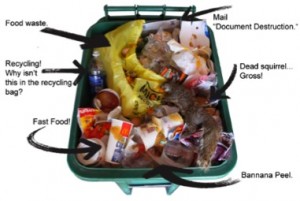All-in-One
All-in-one collection, also known as Mixed Waste Processing (MWP), is a system in which the consumer places all recyclables and trash in a single bin with no separation. Waste is taken to a dirty Materials Recovery Facility (“dirty MRF”) where hand sorting and machinery are used to sort out recyclables.
Dirty MRFs make up less than 5% of all MRFs in the US. This study has useful comparisons of MRF types, including tables and pictures. Due to the low number of dirty MRFs and difficulty obtaining accurate data (often it is self-reported and unregulated), there are varying estimates on its effectiveness. However many studies have shown that dirty MRFs have lower than 20% recycling recovery rates due to contamination. Unfortunately it is often the preferred method of consumers as it requires minimal effort.
Pros
- Requires no consumer participation, education, or sorting (see also in cons)
- Can be used to recover recyclables missed in consumer separation
- Impact maximized when co-located with single stream MRFs or composting facilities
- Good for homogenous materials, like Construction and Demolition waste
Cons
- Dirty MRFs do not address a fundamental problem: the culture of disposability. The notion that products can simply be thrown away indicates a lack of responsibility for the resources one consumes. Separation raises awareness and encourages lifestyle change.
- Very high levels of contamination lead to low recovery rates and low-quality end product
- Contaminated materials require extra processing or are outright rejected by recyclers and sent to landfills. The export market for these lower quality materials are also shrinking; China has begun to crack down on such imports.
Bottom Line
Mixed Waste Processing is not appropriate as a primary recycling option, but it is useful as a “last effort” in catching missed items.





